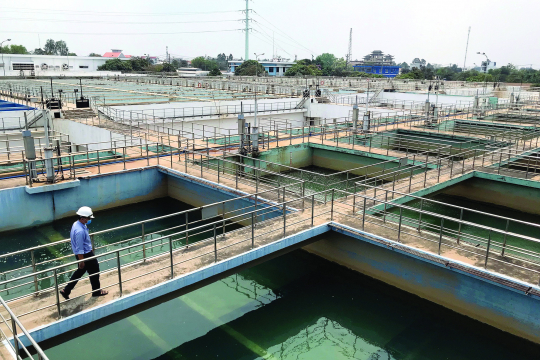The reform of the water sector requires the consensus of the people and a reasonable change management roadmap. In Vietnam in general, or in large cities like Ho Chi Minh City specifically, there is no need to search far for lessons.
Water is essential for life, but not everyone has access to clean and affordable water. In Ho Chi Minh City (HCMC), the largest city in Vietnam, the water sector faces many challenges in providing safe and reliable water services to its residents. The city's main water source is the Saigon-Dong Nai river system, which is increasingly polluted by industrial and agricultural activities. Climate change also poses a threat to the water supply, as saltwater intrusion affects the quality of freshwater.
Multiple problems with water supply
The water company in HCMC, SAWACO, was established in 1874 and has a long history of serving the city. However, its infrastructure is outdated and inefficient, resulting in high water losses and low water pressure. The water tariffs are low and do not cover the full cost of production and distribution. Many households have to use additional devices to filter or boil the tap water before drinking or buying bottled water, which increases their expenses.
How can HCMC reform its water sector to achieve sustainable development and meet the needs of its people? A possible model to learn from is Phnom Penh, the capital of Cambodia, which has transformed its water sector from a dismal state in the 1990s to one of the best performers in developing countries today.
Phnom Penh implemented reforms
Phnom Penh faced similar problems as HCMC in the past: inadequate water supply, poor water quality, low water tariffs, high water losses, and low customer satisfaction. The turning point came in 1993 when a new management team took over the Phnom Penh Water Supply Authority (PPWSA) and implemented a series of reforms to improve the company's service delivery and financial viability.
The key reforms included:
- Increasing water tariffs gradually and transparently, based on the principle of cost recovery and social equity. The tariff adjustments were accompanied by service improvements, such as expanding coverage, reducing interruptions, and enhancing quality. Customers were willing to pay more for better service and saw the benefits of the reforms before the new tariffs were applied.
- Enhancing management autonomy and accountability. PPWSA was given the authority to make operational and investment decisions independently, subject to approval by its board of directors and relevant ministries. PPWSA operated as a commercial entity but with clear guidance on its social responsibility.
- Reducing non-revenue water (NRW), which is the difference between the amount of water produced and the amount of water billed to customers. PPWSA invested in upgrading its infrastructure, installing meters, repairing leaks, detecting illegal connections, and enforcing payment collection. As a result, NRW dropped from about 80% in 1993 to nearly 6% in 2011.
Important lessons learned
The reforms paid off: PPWSA increased its revenue and profitability, improved its service quality and reliability, expanded its customer base and coverage, and gained public trust and recognition. Today, PPWSA provides clean and affordable water to almost 100% of Phnom Penh's population.
The success story of PPWSA offers valuable lessons for HCMC and other cities facing similar challenges in their water sectors. The main lessons are:
- Getting prices right. Water tariffs should reflect the true cost of production and distribution while ensuring affordability and access for all. Low or subsidized tariffs are not sustainable or fair. Water users should pay for the service they receive and expect quality improvements in return.
- Getting management right. Water companies should have autonomy and accountability to implement reforms effectively. They should operate as commercial entities with social objectives, rather than as state-owned enterprises with political interference.
Setting even higher goals
HCMC has already set a goal to achieve universal access to safe and affordable drinking water by 2030, as part of the Sustainable Development Goals (SDGs). HCMC also has the potential to lead the country in providing water services - a basic and essential service - for its people. But it needs to overcome many obstacles and make significant changes in its water sector. Learning from Phnom Penh's experience could help HCMC achieve its vision for a better future.
Note: This is a version modified from the original post in Vietnamese, which can be accessed here.
